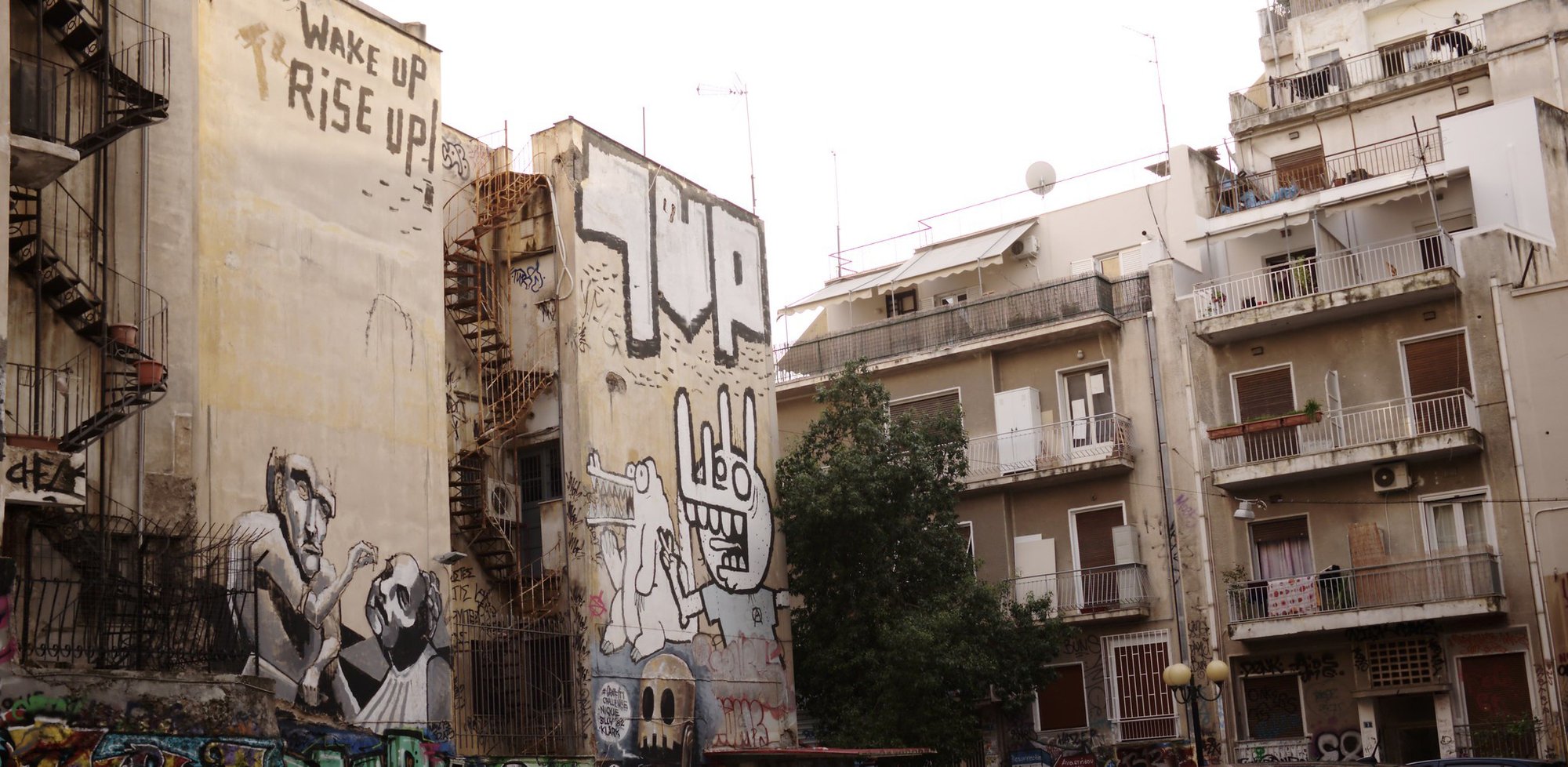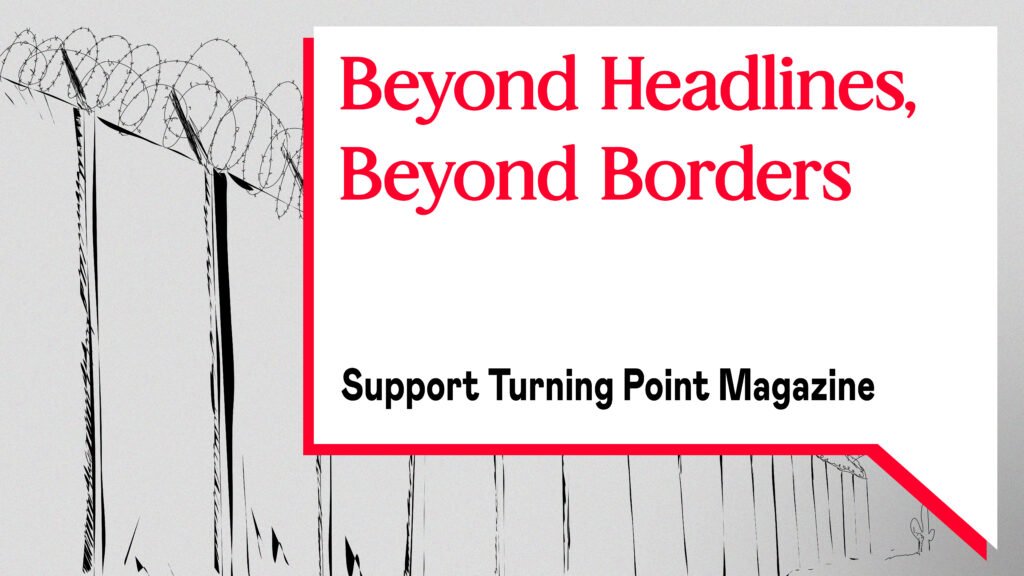Cover photo: “Wake Up Rise Up” slogans on the walls of buildings in Exarcheia. December 12, 2015. ©Nicolas Vigier
The transformation of Athens’ Exarcheia neighborhood is taking place through notable systemic violence. One only has to go to Exarcheia Square, the only square in the neighborhood, to find police squads of all kinds, including special riot police, guarding the three corners of the square 24/7. On August 9, 2022, work began on a new metro station for the city’s line 4, on the square, which met with strong opposition in the neighborhood.
Before the right-wing conservative party, New Democracy, came to power, the police rarely set foot in Exarcheia—except after demonstrations and confrontations took place. Today, the neighborhood seems to be under occupation: the public square is barricaded, the metro construction site is guarded by police forces and people are getting arrested, often unjustifiably, particularly those who dare criticize or even physically oppose the construction project. Several times a day, a group of a dozen or so hyper-equipped riot police march through the streets of the neighborhood to make way for those who will replace them on guard duty—a veritable parade. Exarcheia is being transformed at the whim of the authorities and businesses, and the state wants this to happen as visibly as possible.
The issues at stake in Exarcheia extend far beyond the neighborhood. In Greece, the name Exarcheia evokes something for most people. The neighborhood is known as one of the historical cradles of organized resistance to the colonels’ dictatorship—that took power in Greece in 1967—as it is home to the polytechnic school where students were attacked by Greek army tanks on 17 November 1973, resulting in the deaths of 22 people. This event was decisive in the fall of the dictatorship in 1974.
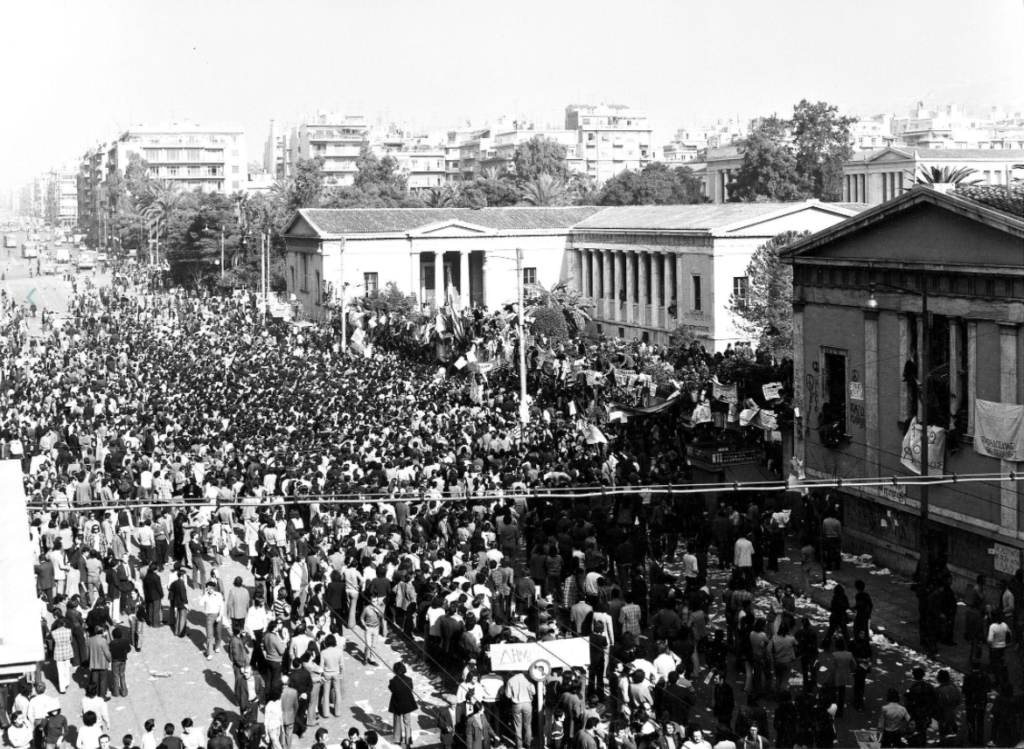
Exarcheia was also home to several publishers, printers and booksellers who helped spread anti-authoritarian and libertarian ideas in Athens. In 2008, at the beginning of the financial crisis which severely affected the country, the neighborhood became the starting point for riots that took place across the country in response to the December 6, 2008, shooting of 15-year-old Alexis Grigoropoulos by police. On that infamous evening, Alexis was hanging out in the neighborhood with a friend, they posed no danger to the police, who shot him in the heart with live ammunition, killing him. His murder shocked the country and remains a symbol of the police violence and state oppression that is particularly prevalent in Exarcheia. In addition to these landmark events, the neighborhood was home to libertarian poets and composers such as Katerina Gogou and Nicolas Asimos, who have gone down in popular history as icons. Exarcheia is seen as a hotbed of resistance, and as such is under attack. This attack is taking place most obviously through gentrification.
Gentrification is always violent, but the violence of Exarcheia’s transformation is ideologically and politically charged. It directly and overtly targets anarchists and the radical left and strikes at all levels. It strikes at those who stand against government policies, as it attempts to push them out of spaces in which they can meet, gather and express themselves. For passers-by, gentrification is no bargain, as the building sites are taking their toll on pedestrian routes, pavements and public spaces in general. Gentrification is hitting residents hard, sometimes forcing them to leave their homes because of soaring rents.
According to a study carried out by the Potamianos property group, rents in Exarcheia rose from €5.5 per square meter to €8.5 per square meter between 2017 and 2022, an increase comparable to prices before the 2009 crisis. Today, one only has to visit the Spitogatos property rental website to see that there is no house rented for less than €10 per square meter, meaning that prices have doubled since 2017. According to Kathimerini newspaper, Exarcheia experienced the second highest increase in rents in Athens between 2019 and 2023. In Exarcheia, many leases are no longer renewed; they are replaced by short-term lets or much more expensive leases. Buildings are being constructed and renovated and gentrification is hitting small shops, who have to find ways to survive alongside trendy new businesses. Finally, gentrification attacks the memory of places, as the transformations that take place attempt to erase all traces of the neighborhood’s history of resistance.
Touristification is a real danger for Exarcheia. Paid guided tours aimed at tourists invite them to discover the “alternative” side of the neighborhood as an attraction. Expressions such as “bohemian enclave” or “rebellious spirit” are often used to sell Exarcheia as a product of consumption. On their website dedicated to tourism, the municipality of Athens describes Exarcheia as follows: “Rebels with, and quite often without, a cause have earned Exarchia a reputation as the turf of anarchists and radicals.” Yet, on the ground, any form of protest is severely oppressed. Gentrification and touristification would not be so efficient without the strong support of the media, conveying the idea that the neighborhood is now “cleansed” of those elements considered “dangerous” (drugs, mafia, etc.) and that Exarcheia has become an investment opportunity and a must-see.
Some of the remaining spaces of resistance
Before New Democracy came to power, there were many occupations in Exarcheia. Most of them were evicted in 2019 when the conservative right came to power, some even earlier under the Syriza government. Others remain, such as the occupation of the former cinema complex K*Vox, now used as a social center on the corner of Arachovis and Themistokleous streets, which overlooks Exarcheia Square and the metro construction site. It is occupied by the anarchist direct action group Rouvikonas and the self-managed health structure ADYE. K*Vox is under constant police surveillance and threatened with eviction. One of the founding members of Rouvikonas, Giorgos Kalaitzides, was arrested last May for writing a Facebook post stating that if the police continue to stand in front of the building—the same brigade that monitors the metro construction site on Exarcheia square monitors K*Vox—there would be reprisals. The anti-terrorist police, therefore, saw fit to arrest him with great fanfare, an arrest that caused a stir in the press and is symptomatic of the territorial struggle at play in Exarcheia.
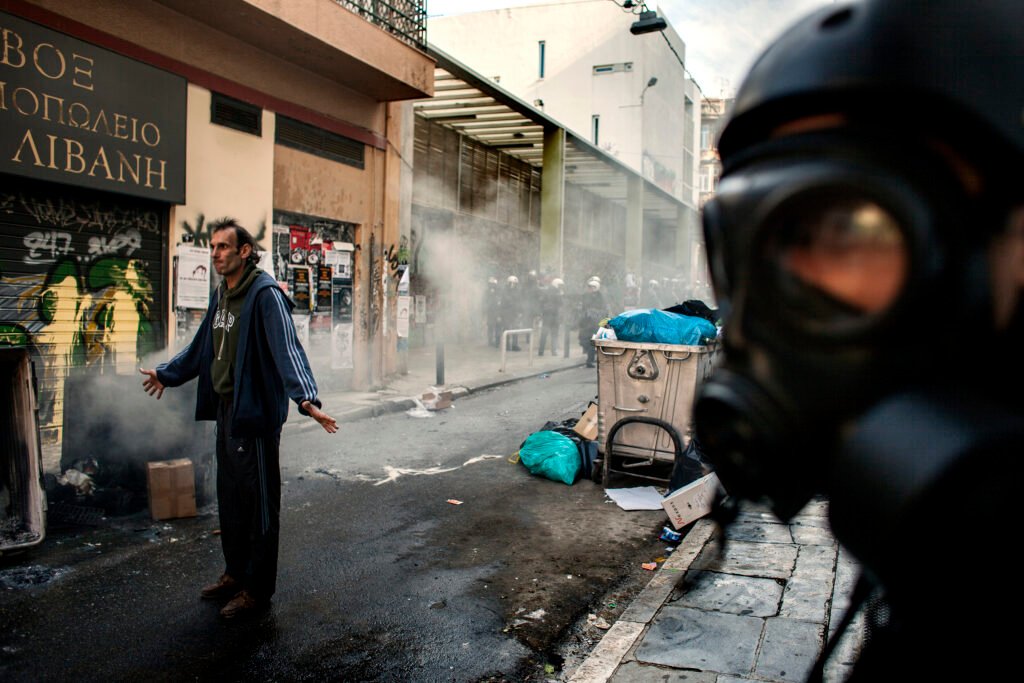
The residential squat Notara 26 was first opened in 2015, when Greece was going through a terrible housing crisis with many people, especially migrants and refugees, living in the streets. It still resists today, despite the ongoing gentrification of the neighborhood. It is the only remaining refugees’ and migrants’ squat in Exarcheia. As with other illegal occupations, Notara 26 is subject to recurrent police surveillance, and electricity and water cuts, especially since the building opposite was bought by investors, probably Israeli according to anonymous sources, likely to house rich foreigners. According to a study published in 2021, the number of foreign buyers of property in Exarcheia has increased significantly from 5% in 2009 to 42.5% in 2018, with the majority of property transactions being carried out by Israeli investors and companies.
Despite the constant threats against the Notara 26 squat, the residents living there and the people actively supporting it are taking part in actions against the gentrification of Exarcheia. Firstly, by resisting the eviction of the squats in the neighborhood, they are putting up real resistance to the expansion of Airbnb and expensive residences. Secondly, by taking part in the actions of the Exarcheia coordination assembly, actions taken against developments that are transforming the neighborhood. The squat regularly takes part in mobilizations organized by other assemblies, such as the No Metro in Exarcheia Square Assembly, or the actions organized by the Assembly for the Defense of Strefi Hill. It also organizes neighborhood demonstrations to denounce the relocation of the poor and the discrimination against refugees and migrants in the city. Talks, events, gatherings, texts, demonstrations and actions are all a part of the same effort to resist the eviction of the poor and the expulsion of politicized places of the neighborhood.
Listing all the places of resistance that still exist in the neighborhood is an impossible task given the scale of this article, but it is worth briefly naming some of them. Navarinou Park was formerly a parking lot. A building project was announced in 2009, but neighbors opposed it and decided to transform the parking lot into a park for the neighborhood. It still stands today as a self-organized park, hosting activities for kids but also discussions and events aiming at promoting anti-capitalist struggles. It is organized through a self-managed assembly like many other spaces in Exarcheia.
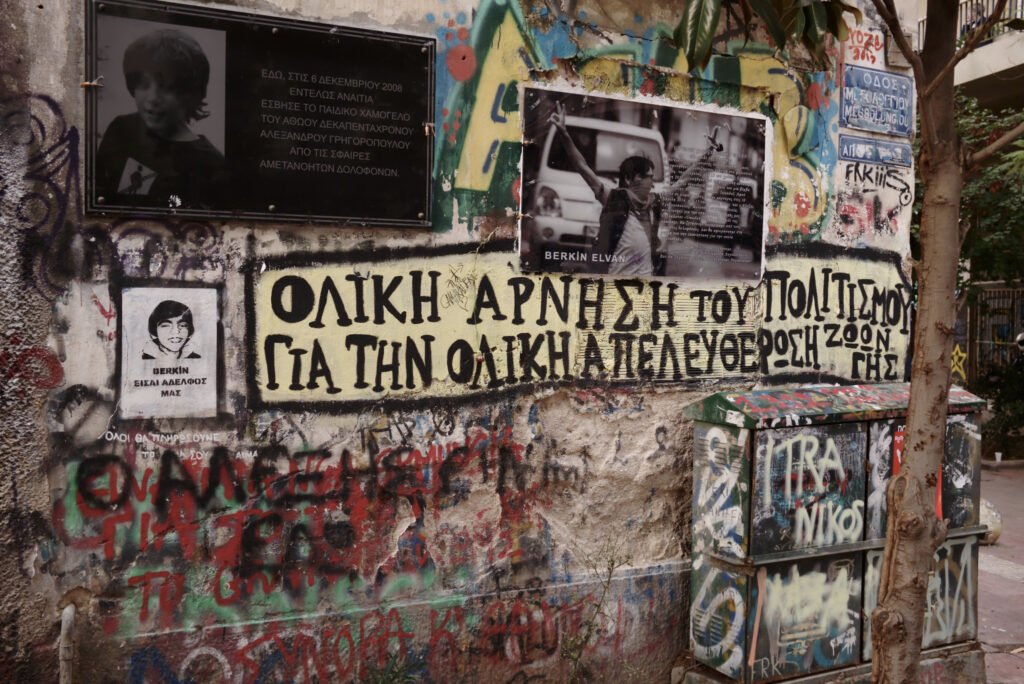
A memorial to Alexis Grigoropoulos is also one of those places resisting gentrification that is worth mentioning. It is situated on the corner of Tzavella and Mesollogiou streets and was literally threatened by the housing developments taking place there. To preserve the memory of the young Grigoropoulos, a memorial made of concrete and marble was built in 2022 by dozens of volunteers. A large fresco was also painted on one of the blind façades of Tzavella street, and events were organized in parallel to preserve Alexis’ memory and the riots that followed his assassination by the police.
Also, let us mention Exostrefis, a small, occupied restaurant used as a social centre that recently sprang up on Strefi hill in Exarcheia. Some weeks ago, it was the subject of an attempted eviction staged by the state and supported by the media. The police “evacuated” the premises at a time when they were empty, all this was done to get media coverage, so that the police could present themselves in the best possible light, working, according to the press, for the “safety of the residents.” However, the residents do not feel safe in the neighborhood, and this is mainly due to the police presence. Exostrefis still functions today as a social centre and hosts discussions, solidarity events and other activities.
If we do not resist in hills and squares, our neighborhoods will only be enjoyed by corporations
One of the most emblematic victories in the fight against gentrification in Exarcheia was undoubtedly that of the Assembly for the Protection of Strefi Hill. This hill had been targeted by a developer, PRODEA, who, in order to boost its investments and increase property values in the surrounding area, had set out to privatize part of Strefi by building a café, a playground, enclosing areas and installing cameras. As with the metro project, there was no public consultation, no participatory process, nothing. The company had offered a development plan to the municipality and implementation was almost immediately initiated with the support of the previous municipality, whose mayor was none other than the prime minister’s nephew, Kostas Bakoyannis.
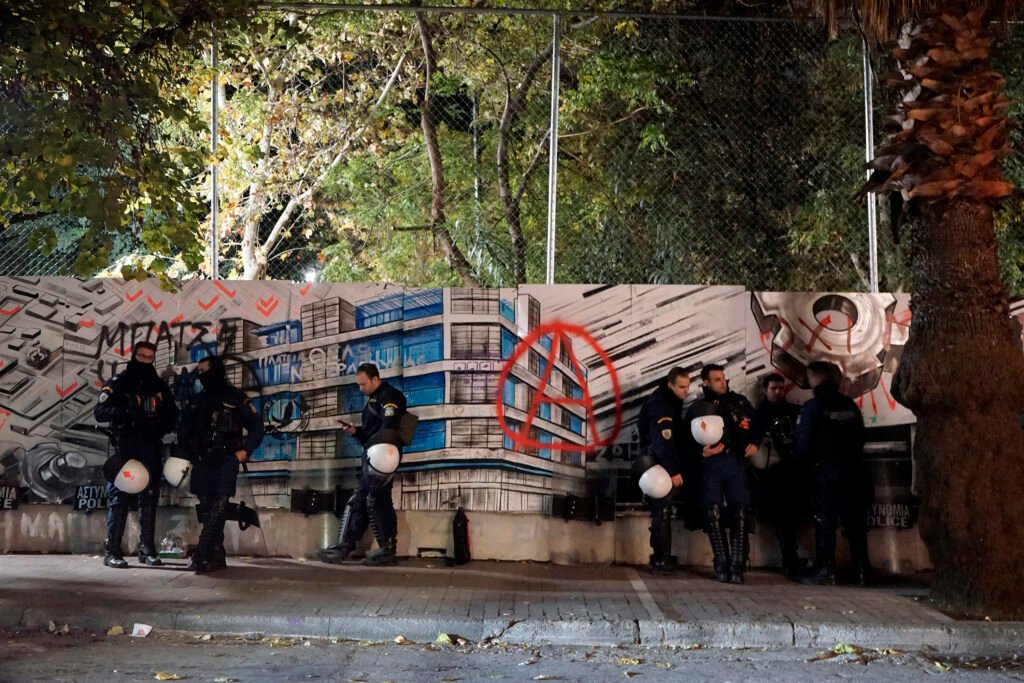
As with the metro project in Exarcheia Square, a dozen or so police officers kept a permanent watch over the work on Strefi Hill. The members of the Assembly for the Protection of Strefi Hill used every possible means to prevent what they saw as the destruction of the site. Sabotage, legal actions, denunciations, campaigns, mobilizations, but above all daily maintenance and cleaning of the hill, so many efforts to preserve the wild and free character of one of the only places that escapes the concrete development of Exarcheia. Their efforts have paid off, as PRODEA abandoned their project last February. Today, the Assembly continues to look after the hill, with self-organized worksites organized every week to fill in and clear away the rubble, clean up, create signposts and carry out other small-scale improvements.
Exarcheia belongs to its residents and occupants, and is steeped in history and struggle. The fight against the transformation of the neighborhood is a daily struggle made by people who only arm themselves with the strength of their political convictions to fight. By their daily presence in the neighborhood, and by their sheer determination, they manage to resist property developments, sometimes successfully, sometimes at a loss. Despite all the changes willed by property developers, Exarcheia is teeming with militant energy that will be very hard for the real estate industry to wipe out.
Eva Betavatzi
Eva Betavatzi is an architect involved in the housing justice movements in Belgium and Greece and she has also conducted research on debts.
